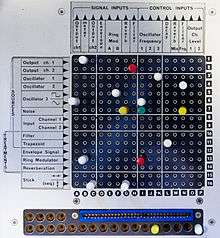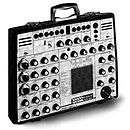EMS VCS 3

Note: it has printed logo: “V.C.S. 3”.
The VCS 3 (or VCS3; an initialism for Voltage Controlled Studio, version #3) is a portable analog synthesiser with a flexible semi-modular voice architecture, by Electronic Music Studios (London) Limited (EMS) in 1969.[# 1]
This product was called various names by EMS. For example, the printed logo written to the front left of products are: “V.C.S. 3” or “The Putney (VCS 3)” on the earlier version, then “The Synthi (VCS 3) II” on the later version (Synthi VCS 3 II).[# 2] (See details on below photographs)

“The Putney (VCS 3)”

“The Synthi (VCS 3) II”
History
It was created in 1969 by Peter Zinovieff's EMS company. The electronics were largely designed by David Cockerell and the machine's distinctive visual appearance was the work of electronic composer Tristram Cary. The VCS3 was more or less the first portable commercially available synthesizer—portable in the sense that the VCS 3 was housed entirely in a small, wooden case, unlike previous machines from American manufacturers such as Moog Music, ARP and Buchla which were housed in large cabinets and were known to take up entire rooms.
Significantly, it retailed for just under £330 in 1969 in the UK. Many people (including the synthesizer enthusiast Gordon Reid in his articles on the EMS company for Sound on Sound magazine in 2000 [1]) found it unsatisfactory as a melodic instrument due to its inherent tuning instability. This arose from the instrument's reliance on the then-current method of exponential conversion of voltage to oscillator frequency, an approach also implemented, with fewer tuning issues, on analog synthesizers by other companies. However, the VCS 3 is renowned as an extremely powerful generator of electronic effects and processor of external sounds .
The VCS 3 began to find popularity among artists looking to create exotic synthesised sounds. As a result, prices for the synthesizer climbed much higher than the original asking price.[note 1]
The first album to be recorded using only the VCS 3 was "The Unusual Classical Synthesizer" on Westminster Gold.[2]
The VCS3 was popular among progressive rock bands and was used on recordings by The Alan Parsons Project, Jean-Michel Jarre, Todd Rundgren, Hawkwind, Brian Eno (with Roxy Music), King Crimson, The Who, Gong, and Pink Floyd, among many others. A well-known example of its use is on The Who track Won't Get Fooled Again from Who's Next. In this instance the synthesizer was used as an external sound processor, with Pete Townshend running the signal of a Lowrey organ through the VCS3's filter and low frequency oscillators. Pink Floyd's "On the Run "(from The Dark Side of the Moon) made use of the VCS 3's oscillators, filter and noise generator, as well as the sequencer. Their song "Welcome to the Machine" also used the VCS 3. The bass throb at the beginning of the recording formed the foundation of the song, with the other parts being recorded in response.

Description
The VCS3 has three oscillators (the first two oscillators are normal oscillators and the third an LFO or Low Frequency Oscillator), a noise generator, two input amplifiers, a ring modulator, 24dB/octave voltage controlled low pass filter (VCF), a trapezoid envelope generator, joy-stick controller, voltage controlled spring reverb unit and 2 stereo output amplifiers. Unlike most modular synthesiser systems which use cables to link components together, the VCS 3 uses a distinctive patch board matrix into which pins are inserted in order to connect its components together.
- Keyboards controller
_%26_DK-1_keyboard_(1969)%2C_Mus%C3%A9e_de_la_Musique_de_Paris.jpg)
connected to VCS 3 (rear)
Although the VCS 3 is often used for generating sound effects due to lack of built-in keyboard, there were external keyboard controllers for melodic play. The DK1 in 1969 was an early velocity sensitive monophonic keyboard for VCS 3 with an extra VCO and VCA.[# 3] Later it was extended for duophonic play, as DK2, in 1972.[# 4] Also in 1972, Synthi AKS was released, and its digital sequencer with a touch-sensitive flat keyboard, KS sequencer,[# 5] and its mechanical keyboard version, DKS,[# 6] were also released.
- Related models
The VCS 3's basic design was reused by EMS in many other of their own products, most notably in the EMS Synthi 100 (1971),[# 7] and the Synthi A (1971)[# 8] and AKS (1972) (essentially a VCS 3 housed in a plastic briefcase). The AKS also has a sequencer built into the keyboard in the lid.[# 9]
A former agent of EMS in the United States, Ionic Industries in Morristown, New Jersey, released a portable-keyboard VCS 3 clone. The Ionic Performer, released in 1973, had circuitry based on that of the VCS 3's. It replaced the patch board matrix with over a hundred push-buttons, and added built-in keyboard and effects units.[3]
-

EMS Synthi A (1971),
also called Portabella[# 1] -

EMS Synthi AKS (1972)[# 2]
-

EMS Synthi 100 (1971),
formerly Digitana, also called The Delaware[# 3]
Cite error: There are <ref group=#> tags on this page, but the references will not show without a {{reflist|group=#}} template (see the help page).
Development
The original VCS No.1 was a hand-built rackmount unit with two oscillators, one filter and one envelope designed by Cockerell before the formation of EMS. When a benefactor, Don Banks, asked Zinovieff for a synthesiser, Zinovieff and Cockerell decided to work together on building an instrument that was small, portable, but very powerful and flexible. Thus came the VCS3, an entire new class of musical instrument.
In popular culture
A modified EMS VCS3 is presented as the "Harrington 1200" automatic song-writing machine in the "Music" episode of the British comedy Look Around You.
Notable users
Note
References
- Hinton, Graham (December 2002). "EMS: The Inside Story". Electronic Music Studios (Cornwall).
- Hinton, Graham (December 2002). "A Guide to the EMS Product Range - 1969 to 1979". Electronic Music Studios (Cornwall).
- Reid, Gordon (2000). "All About EMS, Part 1". Sound on Sound (November 2000).
- Reid, Gordon (2000). "All About EMS, Part 2". Sound on Sound (December 2000).
- ↑ Reid Nov. 2000.
- ↑ https://sites.google.com/site/krakatack/unusualstuff
- ↑ Dennis Bathory-Kitsz. "Killer - My Ionic "Performer" Synth (from Ionic Industories, made by Alfred Mayer)".
- ↑ Todd Rundgren is pictured with a VCS3 on the inside of his bifold double album "Something/Anything?"
- models
- 1 2 "VCS3 (aka The Putney) - The Products". Electronic Music Studios (Cornwall).
- ↑ "Synthi VCS3 II - The Products". Electronic Music Studios (Cornwall).
- ↑ "DK1 (aka The Cricklewood) - The Products". Electronic Music Studios (Cornwall).
- ↑ "DK2 - The Products". Electronic Music Studios (Cornwall).
- ↑ "KS - The Products". Electronic Music Studios (Cornwall).
- ↑ "DKS - The Products". Electronic Music Studios (Cornwall).
- ↑ "Synthi 100 (formerly Digitana, aka the Delaware) - The Products". Electronic Music Studios (Cornwall).
- ↑ "Synthi A (formerly Portabella) - The Products". Electronic Music Studios (Cornwall).
- ↑ "Synthi AKS - The Products". Electronic Music Studios (Cornwall).
External links
- official
- "Electronic Music Studios Home Page". Electronic Music Studios (Cornwall).
- "An advertisement for the company, "every nun needs a Synthi"". Electronic Music Studios (London), Ltd.
- "EMS Home". EMS Rehberg (Germany).
- articles
- modification & resources
- Graham Hinton. "A Guide to EMS VCS3 & Synthi A/AKS Modifications & Servicing". Hinton Instruments.
- "Information on the EMS synthi A, KS and VCS3".
- software emulation
- "XILS 3" from XILS-lab
- "Synthi Avs Plug-In". EMS Rehberg. — A (commercial) VST simulation of a VCS3/Synthi A
- "Cynthia". — A free VST based on the architecture of VCS3/Synthi A
- "iVCS3". — Official EMS iOs emulator by apeSoft